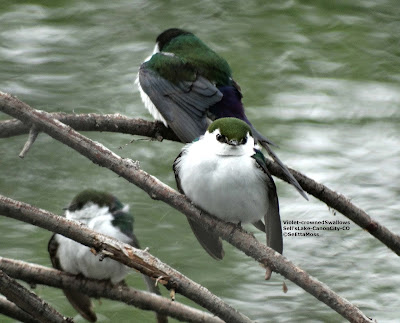
I found this dark Ibis foraging in the muck draining off the stockyard in Ordway, CO (yeah,what a yukkie place to forage). This ibis was alone though there was a second dark ibis a few hundred yards away. It is in Basic (non-breeding plumage) as evidenced by lack of chestnut coloration on body and by a duller brownish color without the iridescence found during breeding season. There is also white streaking on the head and neck that occurs in non-breeding plumage.

Most field guides as well as
Birds of North America (BNA) online note that White-faced Ibis in Basic plumage look very much like Glossy Ibis in that non-breeding plumage. In National Geographic's
Birding Essentials addresses the difficult distinction between White-faced and Glossy: "All adult (and even most juvenile) Glossy Ibis will show a thin powder-blue line above and below the facial skin but not around the eye." BNA states, "Pale blue-gray skin bordering facial skin on Glossy Ibis may be confused with white feathering of White-faced, but note blue-gray lines of Glossy do not extend behind eye." This ibis shows thin light blue lines bordering the eyes but not going behind them so I believe this is a Glossy Ibis. SeEtta

 I found this dark Ibis foraging in the muck draining off the stockyard in Ordway, CO (yeah,what a yukkie place to forage). This ibis was alone though there was a second dark ibis a few hundred yards away. It is in Basic (non-breeding plumage) as evidenced by lack of chestnut coloration on body and by a duller brownish color without the iridescence found during breeding season. There is also white streaking on the head and neck that occurs in non-breeding plumage.
I found this dark Ibis foraging in the muck draining off the stockyard in Ordway, CO (yeah,what a yukkie place to forage). This ibis was alone though there was a second dark ibis a few hundred yards away. It is in Basic (non-breeding plumage) as evidenced by lack of chestnut coloration on body and by a duller brownish color without the iridescence found during breeding season. There is also white streaking on the head and neck that occurs in non-breeding plumage.  Most field guides as well as Birds of North America (BNA) online note that White-faced Ibis in Basic plumage look very much like Glossy Ibis in that non-breeding plumage. In National Geographic's Birding Essentials addresses the difficult distinction between White-faced and Glossy: "All adult (and even most juvenile) Glossy Ibis will show a thin powder-blue line above and below the facial skin but not around the eye." BNA states, "Pale blue-gray skin bordering facial skin on Glossy Ibis may be confused with white feathering of White-faced, but note blue-gray lines of Glossy do not extend behind eye." This ibis shows thin light blue lines bordering the eyes but not going behind them so I believe this is a Glossy Ibis. SeEtta
Most field guides as well as Birds of North America (BNA) online note that White-faced Ibis in Basic plumage look very much like Glossy Ibis in that non-breeding plumage. In National Geographic's Birding Essentials addresses the difficult distinction between White-faced and Glossy: "All adult (and even most juvenile) Glossy Ibis will show a thin powder-blue line above and below the facial skin but not around the eye." BNA states, "Pale blue-gray skin bordering facial skin on Glossy Ibis may be confused with white feathering of White-faced, but note blue-gray lines of Glossy do not extend behind eye." This ibis shows thin light blue lines bordering the eyes but not going behind them so I believe this is a Glossy Ibis. SeEtta


Comments